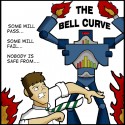The “Bell Curve” Is it ringing on the straight and narrow?

It’s a grading system at many Post Secondary facilities.
Imagine scoring 70% on an exam and still ending up with an “A” – sounds too good to be true, doesn’t it? Now, imagine trying your hardest and feeling like you’re doing really well but somehow never managing to score anything above a “C”. This false sense of achievement or defeat may be the reality for students at post-secondary schools that use the “bell curve” grading system.
This form of grading uses statistics – a graph of the normal bell curve distribution – to determine a student’s grade based on where they fall along the curve relative to everyone else. A number of students will end up with A’s or F’s while the majority will get C’s. But is it fair? Students are graded by being compared to one another, regardless of actual learning.
“I am not in favour of using the bell curve as a matter of policy. It does not help a student’s progress and does not give them an accurate measure of the extent to which they have met learning outcomes for course material” said Debby Cleveland, Program Head of Human Resource Management at the BCIT School of Business.
“When you have large numbers of students from a representative sample of the population, you would expect grades to fall naturally into a bell shaped curve. The students at BCIT (and at many other post-secondary institutions) are a select group, and therefore not representative of the general population. It is artificial to make their grades ‘fit the curve’ and not in any way fair” noted Cleveland.
“I like straight grading better because in a sense [it’s] more fair. If bell curving depended on how smart your graduating class [is] then I don’t think it would be that accurate” Annie Gong, U of Waterloo B.Sc. graduate and current BBA student at BCIT, said.
Although many post-secondary institutions across Canada do not use the bell curve grading system, those that do may not be using the same grade curving algorithms to compare and calculate final grades. Even if an accurate standard is determined, it must be consistent across faculties and programs in order for it to be fair – especially when students are vying for limited spots in grad school.
When your grade is dependent on the performance of others, it can lead to a false sense of progress and even underachievement. However, in more difficult or advanced courses it may be the only way to measure results while still meeting the quotas determined by the scores across the country.
“I would have preferred [straight percent-based grading] in courses I did well in but not so much in courses I didn’t – I guess you can’t have the best of both worlds” said Gong.
Although the alternative would be to banish the bell curve system all together, the consequences could be detrimental to many reputable universities. In other words, students may not be able to meet the expectations set by these policies and over time GPA’s will suffer and bring down the school’s credibility.
On the other extreme, some instructors think students will be better off without any form of grades. Pinpointing the student’s strengths and weaknesses with a clear course of maintenance and improvement is a proven way to successfully progress through school, regardless of grades and scores.
“Advancement comes from getting qualitative feedback about what areas you have mastered and what you still need to learn” states Cleveland.
NOTE : Bell Curve comic, provided by www. same-shirt.com, created by Mark Tomczak





Laisser un commentaire!